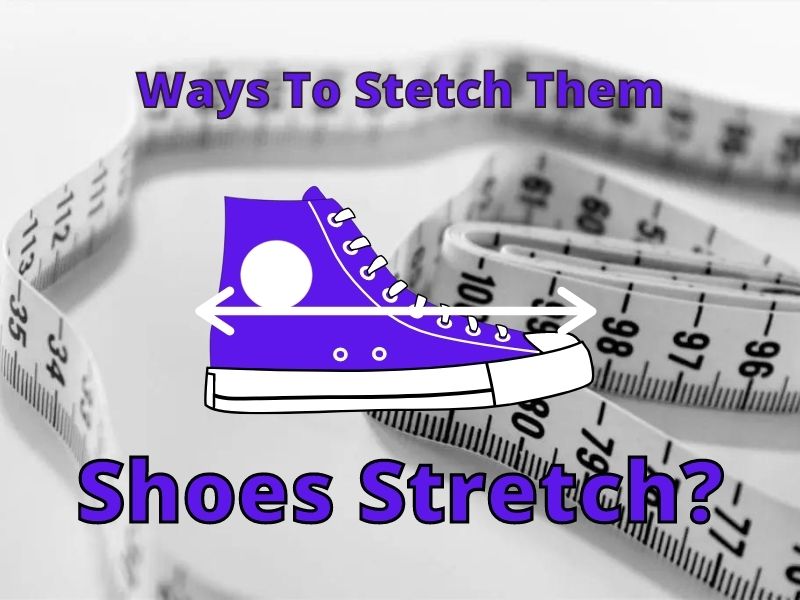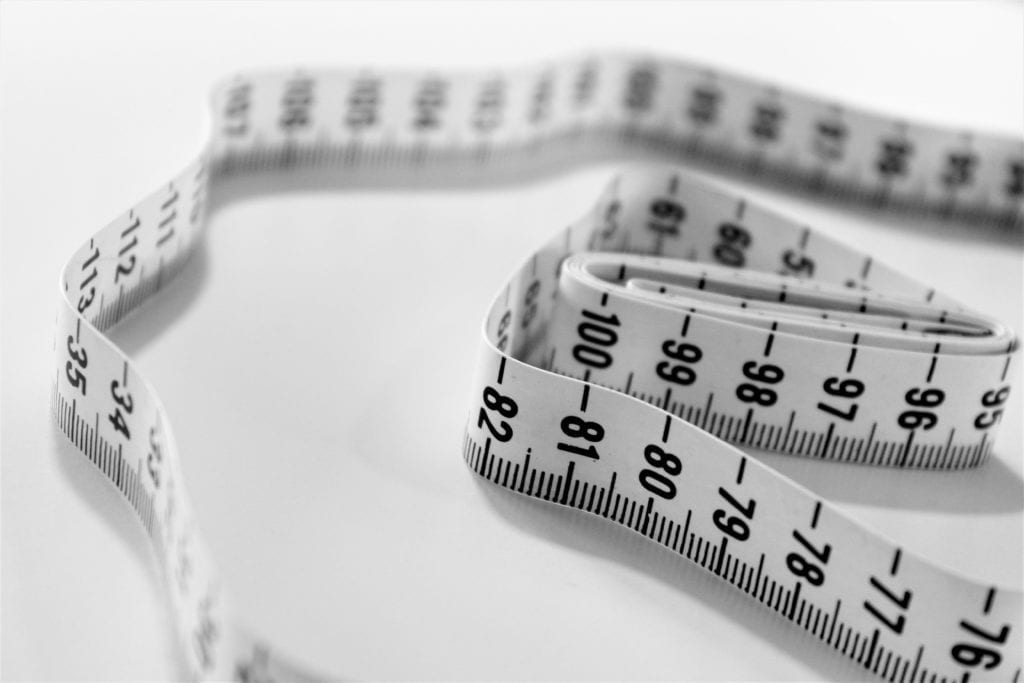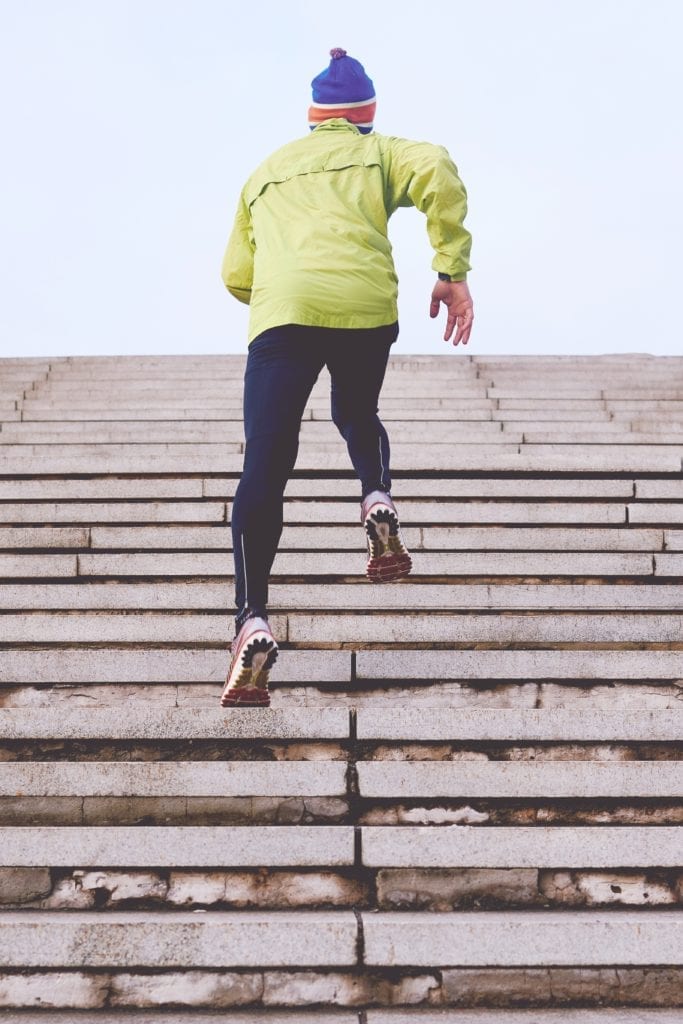As a teenager, I once found a pair of tennis shoes I wanted, but the shoes weren’t quite the right size. I hoped they would stretch out as I wore them. I was given the impression from my Mom and the salesperson that shoes do stretch out a bit. Were they right?
Can I stretch my shoes if I need to? Yes, your shoes can stretch. Shoes have some ability to expand. Materials that were once tight, can either relax over time or be made to stretch. Not all materials stretch well. That’s where you’ll need to make a choice whether to purposely stretch your shoe or not.
After I bought my tennis shoes, I soon found they were too uncomfortable to wear for any length of time. Now before I purchased a pair of shoes, 99% of the time I will get shoes that fit my feet comfortably without it needing stretching. Yet, there are strategies you can use if you already have tight shoes.
Here’s a helpful chart to remind you of ways to stretch your shoes.
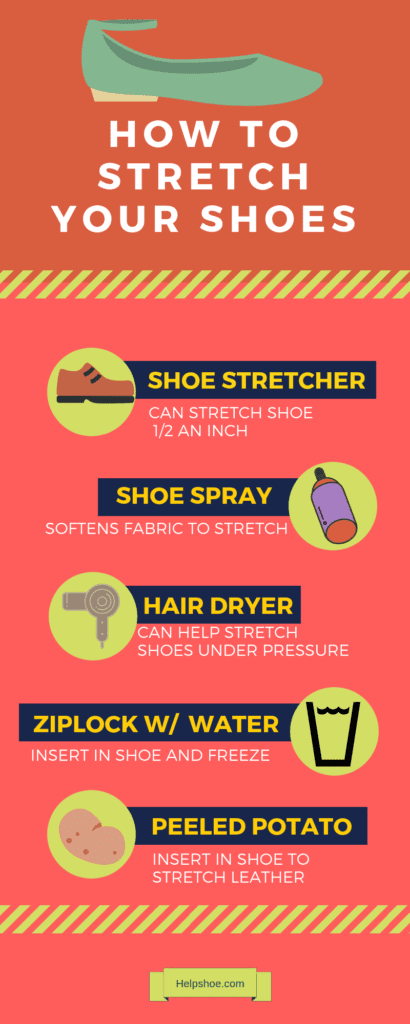
Should You Stretch Your Shoes or Not?
I now know choosing a pair of tight shoes comes at a price. This usually involves foot discomfort, and spending extra time and money. Are you willing to pay that price?
First, you’ll need to know if you’re committed to your shoes. If you know you will not return them, then you can start the stretching process. If you’re not sure, then decide before the return date so you can get your money back if you will be returning them. Second, return your shoes or begin the stretching process.
Stretching out your shoes involves using a device or method that helps create more room for your feet. This involves stretching the upper material of the shoe. Here are some methods you can try.
- Shoe stretchers (Amazon Link) can help widen, lengthen, and heighten your shoes. It applies pressure in the upper material to create a more relaxed fit. Put the stretcher in and apply the correct amount of pressure for your needs, and wait at least 24 hours.
- The advantage of this method is that it only takes one application to work.
- The disadvantage is you’ll be out about $20 when you buy a shoe stretcher.
- Shoe spray (Amazon Link) for leather, suede, nubuck, and canvas shoes will help relax these materials and allow them to be stretched for faster stretching.
- The advantage is your shoes will likely stretch easier.
- The disadvantage is you’ll likely spend about $10 and you’ll need to be careful with certain sprays on certain types of shoe colors, so the color will remain the same.
- Shoe trees (Amazon Link) can work on shoes that only need to stretch just a bit.
- The advantage of getting a wooden shoe tree is it will help remove moisture from your shoes. You may already have purchased these for your shoes.
- The disadvantage is you’ll likely need to continue using it repeatedly because it is designed to help retain shape more than stretch shoes.
- Wearing your shoes on short trips out may be one of the best solutions, especially with leather(article).
- The advantage is that you can better judge how tight they are and if they really need to be stretched. If they relax and start to become unnoticeable the more you wear them, you might not need any further action.
- The disadvantage is you may start to get blisters or excessive rubbing. There may be another hidden advantage here. You can now return your shoes since you haven’t stretched them out and get a new pair.
- (DIY) Do it yourself stretching methods. Be careful and use at your own discretion. (The following ideas come from the video- Ways to Stretch Your Shoes at Home )
- The advantage of this method is it will usually cost no money.
- The disadvantage is the time needed and mistakes may occur during this process.
- For leather shoes, you can wear a thick sock, put your shoe on, and use a hair dryer to heat up the uppers for 30 second periods. Then when you take your foot out and get a thinner sock to wear the fabric should stay stretched. Don’t forget to use a leather conditioner after.
- Using a plastic ziplock bag, pour water into it, and then place it in your shoe so that the area that needs to be stretched is in full contact with the bag. Place your shoe with the water filled ziplock bag in the freezer so that the water continues to remain in contact with the upper and let them stay overnight. The water will expand and the material will as well.
- Stuffing your leather shoe with a peeled potato can also stretch your shoe. Make sure the potato is peeled to fit and push on the areas you need to be expanded. The moisture from the potato will get into the leather and allow it to loosen. Later when your shoes dry, the leather will stay in that same expanded position.
Once you’ve stretched out your shoes, they are likely to stay stretched out unless they are exposed to extreme temperatures and excessive moisture (article) or water. So next time you’re buying a new pair of shoes, you’ll need to decide if it’s worth the effort to stretch your shoes.
Can I Buy A Size Smaller Shoe?
You may have been tempted to buy a size smaller than your normal shoe size. You’re at the store and see the shoe you want to buy but not in your exact size. You try on a size smaller and say, “well… it could work?”
Shoes come in many types of materials, sizes, shapes, and types. Stretching may occur over time, depending on the type of material. For example, the EVA foam in a sole will compress over time, but leather soles and plastic high heels will not compress.
Before buying a size smaller, you buy you’ll want to consider these questions.
- Can I return them? Consider asking a salesperson or doing an internet search about the store policy.
- Will I need them right away? You may not have a choice if you need it tomorrow. Just remember to find out about returns.
- How long will I be wearing them? Some people love to have many pairs of shoes for fashion. If you’re not wearing them often or for a long period, then it might be fine to get a size smaller.
- Are they likely to remain rigid and nonconforming to my foot? Leather can conform well, while man-made materials are less likely to stretch over time.
- Will a size smaller impact my foot, knee, and back health? Everyone has a different type of arch. Our joint health depends on the cushioning of joint fluid, muscles, and cartilage. Smaller sizes can squeeze and apply pressure to feet that influence foot position and, therefore foot and joint health.
- Will I regret this purchase if they are uncomfortable? Consider that less time and energy will be spent over the long run if you take another hour to find better-fitting shoes.
- Do I have time to research and buy a better-fitting pair? If you have a limited timeline, consider getting advice from the salesperson or a few internet reviews. If you have more time, you can get a pair of shoes that fit just right.
- Will buying a smaller size cost me in time, money, and hassle? Likely, you’ll find that you will put more money and time into finding solutions to stretch your shoe.
My experience has taught me not to buy a size smaller. In a rare instance or two, the shoes did relax over time but this took time and the shoes were not excessively tight.
When Buying A Size Smaller Shoe Make Sense?
- When the shoes you like are not available anywhere else.
- When you have knowledge that the shoe can stretch and fit your foot comfortably.
- When will you be returning them if they don’t work out and you have allowed enough time to find another pair of shoes?
- When you can donate them to a friend or charity if you decide not to keep them or return them.
- When you know, there is also a size larger than you can buy if the size smaller doesn’t work out.
- When you make a commitment to yourself that these shoes will not just take up room in your house but will somehow make your investment worth your time, money, and happiness.
Shoe Materials Make A Difference
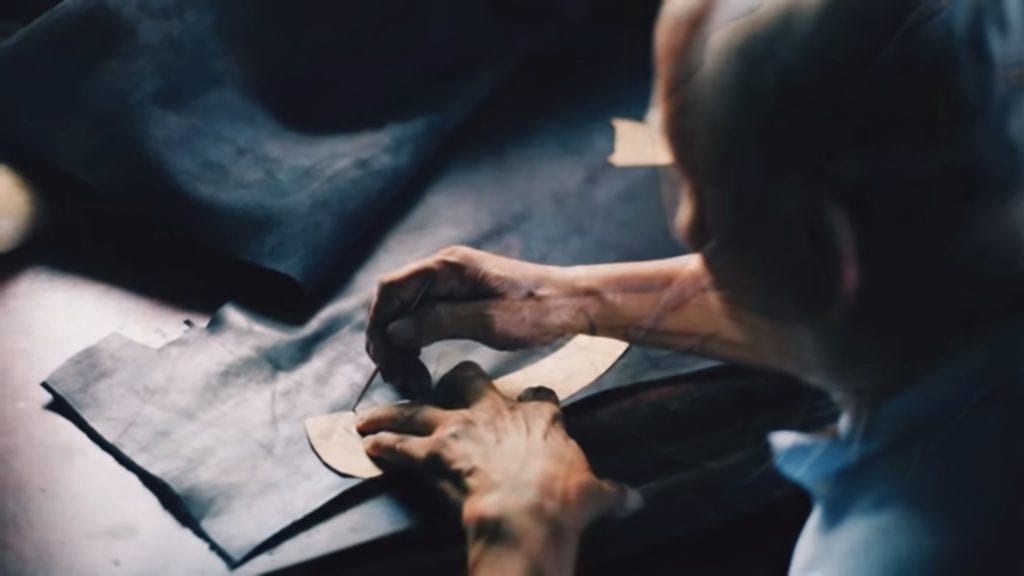
There are so many different shoe configurations it makes sense to take some time to find out what material your shoes are made out of and how that’ll affect your comfort level.
In general, leather shoes will stretch out over time but PU leather will need some type of stretching device to make room for your feet if the shoe is too small.
Natural shoe materials are likely to stretch more easily. These are fabrics like canvas, cotton, wool, and leathers like suede and nubuck. Man-made material is less likely to stretch. These are materials like polyester, nylon, plastics, and PU leather.
Stretching and shrinking can be influenced by the weather.
If your shoes will be out in the rain, you’ll want to consider what materials your shoes are made of. PU leather can handle the rain without much risk of a change in shape. Rain on natural leather will cause damage and stretching.
Your best bet is to find a pair of shoes that fit comfortably as you try them for the first time. Be aware of the type of socks (article) you normally wear, and you will be able to determine if the shoes fit comfortably. Then make sure you know what they are made of to either weather treat them or take care of them correctly.
Fitting Your Shoes Correctly
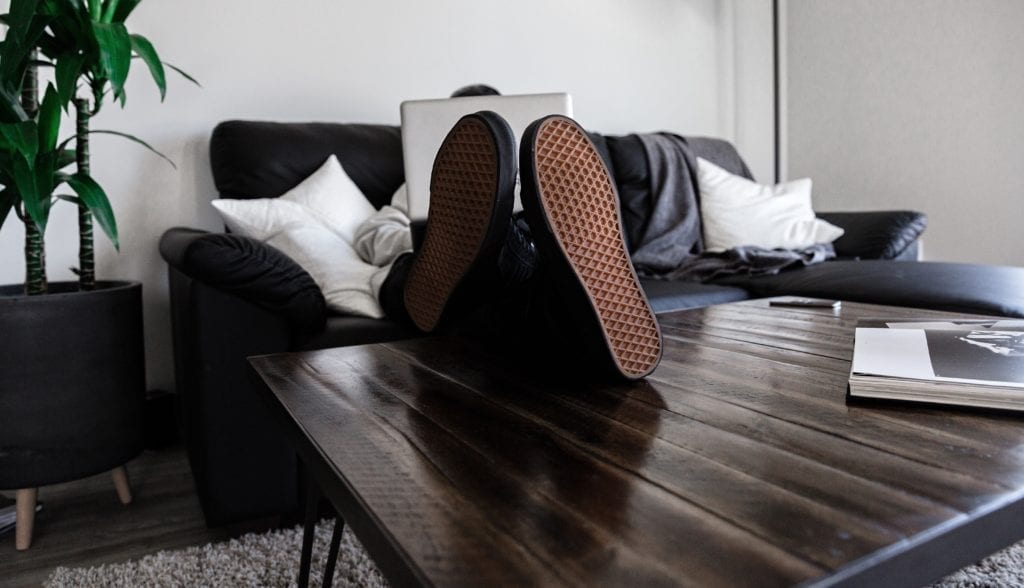
Determining what shoes will fit correctly, remember to buy shoes that do not feel tight. Snug might be okay as long as there’s no rubbing and your toes are able to move freely.
You might need shoes for hiking and decide on a size larger, in case your feet swell. You might be a rock climber and get a size smaller to keep your feet from moving at all.
Getting shoes that fit right the first time will make all the difference. I like to do some research before I buy shoes. And if I need to pay more than expected, I will, because my feet are worth it.
You might have asked yourself whether you should buy a pair of slightly under or oversized shoes. The time trying out shoes at a store is most likely not long enough to evaluate the effective fit of a pair of shoes.
Planning will help make your time effective at the store or online. Make a couple of decisions before your purchase.
- Check that your toes are not touching or rubbing against the front or sides of your shoe.
- Walk and see if your heel is slipping as you walk.
- Recognize when the shoe is tight on the sides. If the width of the shoe is too narrow, you’ll feel like there is more pressure than normal.
Trying before you buy is a good idea, but you’ll likely need more time. The more experience with the shoe, the better. You’ll be able to make sure they fit right. Remember, impulse buying can make you lose time and money that you could better use to buy a wonderful pair of shoes.
Test Drive Your Shoes
Your experience trying new shoes on at the store may be completely different than trying them on while walking for a long distance. When you get them home, start your trial period with your shoes. This will give you some strong indicators of wearability.
Keep track of several items during your shoe test drive:
- Keep your shoes clean (article) and in good condition during the trial period so you have no problem returning them if needed.
- After you’ve worn your shoes for their intended purpose, from a few hours to a day, notice any uncomfortable rubbing, slipping off your heel, achy joints, sweaty feet or moisture in shoes, and anything that is different than a comfortable pair of shoes you’ve worn in the past.
- Take your shoes off and compare them to other shoes you have. Do you notice anything that you didn’t before? Make sure it’s a shoe you really want. I think you deserve it.
- Get a new perspective. Ask someone what they think and see if they think of something you haven’t considered already.
If you’ve finished your test drive, it’s time to decide whether to keep your new shoes or to return them. Don’t be afraid to return your shoes or keep them as long as you know what is best for you.
Keep it business-like. The more you can remove emotions from your decision to purchase your new pair of shoes or return them, the better off you’ll find the decision that you have made will be the best one for you.
Thanks for visiting Helpshoe.com
Related Questions
How to use a shoe stretcher?
Insert the stretcher into the shoe. Rotate the handle until it is snug and rotate the handle 2 to 3 times more. Leave it in overnight and see how much stretch you’ve gotten. Repeat if needed. Shoe stretchers will work better on natural materials and increase the area stretched by about 1/2 an inch.
When to buy a size larger?
Consider buying a larger-sized shoe if your feet swell for any reason, including hiking and pregnancy. If you live in cold weather, it is the perfect excuse for buying a larger-sized shoe because you can wear a few layers of socks to fill in the extra space. For children, a size larger is a good idea since their feet are always growing.

